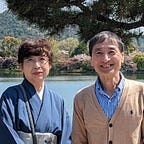An Intimate Exploration into Kyoto: Serene Solitudes & Timeless Tales
— Article 12: Ginkakuji, Another World Heritage Site in Bloom —
I had the privilege of visiting Ginkakuji Temple, a UNESCO World Heritage site established in the 15th century, on March 30th and April 9th, 2022.
On March 30th, the path leading to Ginkakuji and the adjacent river were ablaze with cherry blossoms at their zenith, and the joyous hum of visitors filled the air. On April 9th, the river’s surface became a delicate canvas adorned with the endless descent of cherry blossom petals, presenting an entirely different, yet equally captivating, spectacle.
To the right of the Ginkakuji approach stands the former residence of Kansetsu Hashimoto, a renowned painter who lived from 1883 to 1945 and generously donated the cherry trees. The house and its meticulously designed garden serve as quintessential examples of early 20th-century Japanese architecture. Adding a unique charm are twenty-nine ancient stone towers, dating from the 8th to the 16th centuries, which punctuate the landscape.
Ginkakuji is renowned for its distinctive sand garden, meticulously maintained for over two centuries. The parallel patterns on the foreground, known as Ginshadan, pay homage to West Lake in Hangzhou, China — a subject of reverence in countless Chinese poems and a source of inspiration for ancient Japanese artists. Behind Ginshadan is a round trapezoidal feature, Kogetsudai. Adjacent to the garden, Ginkaku, the temple’s central structure, stands true to its name. Erected in 1489, it retains its original splendor and shares a familial bond with Kinkaku, which I explored in my 8th article, as the names “Kin” (Gold) and “Gin” (Silver) suggest.
For those unfamiliar with the serene elegance of Kyoto, I warmly recommend embarking on your journey with my inaugural piece, “An Intimate Exploration into Kyoto: Serene Solitudes & Timeless Tales — Article 1: Lesser Known Gems.”
Stay tuned for the next installment, where I will uncover the enchanting allure of “Nene Street in Bloom.”
